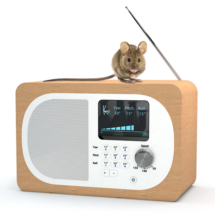
In our day-to-day lives we execute spatially targeted movements with ease and seemingly without much thought. These movements may include reaching for your morning cup of coffee, checking your mirrors on your drive into work, or catching a cricket ball. On the face of it, these actions may seem to cover a broad range of behaviours, but they share a common feature in that they all need to be defined within three-dimensional space – depending on where your hand is when you go to pick up your coffee you may need to move it up or down, left or right, or rotate it slightly to grasp the handle. But how is this three-dimensional motor space coded in the brain?
By recording from neurons in freely behaving mice, Jonathan Wilson and colleagues in Marco Tripodi’s group, in the LMB’s Neurobiology Division, found that the superior colliculus, a region of the midbrain, is where three-dimensional motor space is mapped, and importantly they showed how the activity of neurons in this brain region leads to controlled spatially targeted movement.
As mice primarily interact with their surroundings by orienting their head, rather than moving their limbs or eyes towards targets, the group developed a lightweight head-mounted inertial sensor system to record rotations of the head in three-dimensional space. This system was paired with electrophysiological recordings to determine whether neural activity was related to head movements and whether a map of motor space exists within the superior colliculus. The findings revealed that neurons in the superior colliculus of mice code for head rotations around any of the three rotational axes (the yaw, pitch and roll axes). Neurons whose activity was motor-related showed a preference for a particular angle and direction of rotation, while increased activity of these motion-tuned neurons further modulated the speed of head rotations – the more active the neurons were the faster the mice moved their head.
These results provide the first evidence of a three-dimensional representation of motor space in the superior colliculus and give new insights into the mechanisms underlying the control of spatially-targeted movement. The group suggest that such motor control can be thought of as a combined analogue and digital system in which the displacement angle of the head rotation (the direction the head moves – measured as the yaw, pitch and roll) is defined by the identity of the active neurons (digital coder) while the velocity of that motion is further modulated by the activity of the neurons (analogue coder). This finding suggests that neurons in the superior colliculus not only code for the direction of movement, but also the speed depending on the demands of the task i.e. how fast do I need to move to catch the cricket ball?
By studying the neural representation of spatially-tuned actions in mice, this work also opens up a door to the study of motor-space representations at a genetic level.This will allow for a better understanding of how networks of neurons represent the relationship between space and motor behaviour.
This work was funded by the MRC and the ERC.